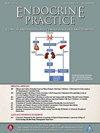临床实践中交替使用的胰岛素类似物的特征:描述性报告
IF 4.6
3区 医学
Q2 ENDOCRINOLOGY & METABOLISM
引用次数: 0
摘要
目的根据成人门诊环境中的换药流程,描述增量素类似物换成等效或更高浓度时的耐受性:这是一项回顾性病历审查,对象是 2022 年 1 月 1 日至 2022 年 11 月 30 日期间在一家大型学术医疗中心的参与家庭医学或内分泌诊所接受治疗的成人患者。由于胰岛素类药物持续短缺,需要对同类不同药物进行治疗调整,因此制定了胰岛素类似物等效表和换药协议。如果患者开始接受推荐的胰岛素类似物换药治疗,并进行了耐受性评估,则将其纳入治疗范围。如果患者不符合纳入标准或无法联系到他们进行换药耐受性评估,则将其排除在外:结果:共有 156 名患者被纳入研究,以确定其特征和对换药耐受性的反应。结果显示,96% 的患者可以耐受胰岛素类似物的互换。58%的患者接受了剂量升级,41%的患者过渡到了同等剂量,1 名患者被视为剂量减少。74%的新疗法需要事先授权。最常见的换药是将 4.5 毫克度拉鲁肽换成 7.5 毫克替扎帕肽、将 4.5 毫克度拉鲁肽换成 10 毫克替扎帕肽以及将 3 毫克度拉鲁肽换成 7.5 毫克替扎帕肽。这些换药患者占总人数的 37.3%,据观察,耐受性达 93%。七名患者不能耐受胰岛素类似物换药。其中五人出现胃肠道反应,两人出现注射部位反应。据估计,换用胰岛素类似物可将达到最大剂量的时间中位数缩短三个月。在这项研究中,没有患者出现中断治疗的情况,即错过一次胰岛素类似物剂量:这份特征分析报告展示了解决胰岛素类似物换药问题的有效方法。通过定义的换药过程可以看出,患者的耐受性很高。未来的研究应继续从疗效和耐受性报告中确认胰岛素类似物换药的有效性和安全性。本文章由计算机程序翻译,如有差异,请以英文原文为准。
Characterization of Interchanging Incretin Analogs in Clinical Practice: A Descriptive Report
Objective
To characterize the tolerability associated with incretin analog interchanges to equipotent or higher strengths based on an interchange process in an adult outpatient setting.
Methods
This was a retrospective chart review of adult patients receiving care through a participating family medicine or endocrinology clinic between January 1, 2022, and November 30, 2022 at a major academic medical center. An incretin analog equivalency table and protocol for interchange was created in response to ongoing shortages and need for therapy adjustments to different medications within the same class. Patients were included if a recommended incretin analog interchange was initiated and a tolerability assessment was conducted. Patients were excluded if they did not meet inclusion criteria or if they were unreachable for tolerability assessments for interchanged agents.
Results
There were 156 patients included for characterization and response to tolerability of interchange. It was determined that 96% of patients tolerated the incretin analog interchange. A dose escalation occurred in 58% of patients, 41% were transitioned to an equipotent dose, and a dose decrease was considered in 1 patient. Prior authorizations were required 74% of the time for the new therapy. The most common interchanges were dulaglutide 4.5 mg to tirzepatide 7.5 mg, dulaglutide 4.5 mg to tirzepatide 10 mg, and dulaglutide 3 mg to tirzepatide 7.5 mg. These interchanges made up 37.3% of the total population and were observed to have 93% tolerability. Seven patients did not tolerate incretin analog interchange. Five experienced gastrointestinal effects and 2 experienced injection site reactions. The interchange of incretin analog was estimated to reduce time to maximum dose by a median of 3 months. During this study, no patients experienced interruption of therapy defined as missing a dose of incretin analog.
Conclusion
This characterization report demonstrates an effective approach to addressing incretin analog interchanges. A high level of tolerability is evident with the defined interchange process. Future studies should continue to confirm effective and safe interchanges of incretin analogs from outcomes and tolerability reports.
求助全文
通过发布文献求助,成功后即可免费获取论文全文。
去求助
来源期刊

Endocrine Practice
ENDOCRINOLOGY & METABOLISM-
CiteScore
7.60
自引率
2.40%
发文量
546
审稿时长
41 days
期刊介绍:
Endocrine Practice (ISSN: 1530-891X), a peer-reviewed journal published twelve times a year, is the official journal of the American Association of Clinical Endocrinologists (AACE). The primary mission of Endocrine Practice is to enhance the health care of patients with endocrine diseases through continuing education of practicing endocrinologists.
 求助内容:
求助内容: 应助结果提醒方式:
应助结果提醒方式:


